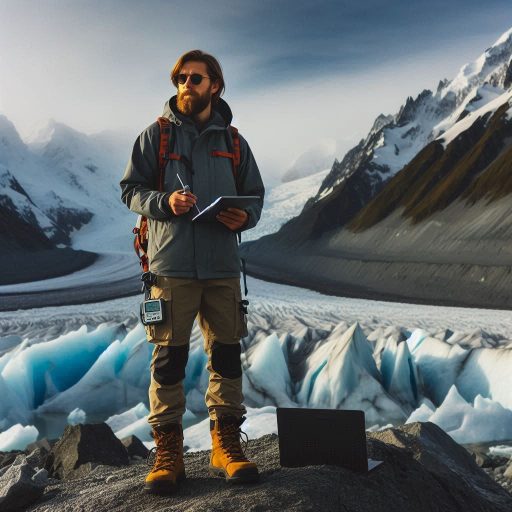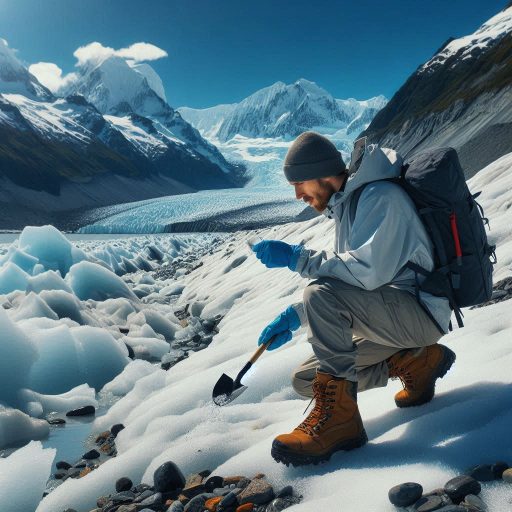Introduction
Global warming refers to the long-term rise in Earth’s average temperature.
This increase results primarily from human activities, especially the burning of fossil fuels.
As greenhouse gases accumulate in the atmosphere, they trap heat and disrupt the planet’s climate systems.
These changes have significant impacts on weather patterns, ecosystems, and sea levels.
Understanding global warming is crucial for developing effective strategies to combat climate change.
Studying trends in global warming allows scientists to grasp its effects on our environment.
By analyzing data, researchers can identify patterns and make predictions about future changes.
This knowledge helps policymakers create informed regulations and initiatives.
It also equips communities to prepare for climate-related disasters.
Understanding these trends supports global efforts to reduce greenhouse gas emissions and promote sustainability.
Climatologists play a vital role in researching global warming.
They collect data from various sources, including weather stations, satellites, and ocean buoys.
This information helps them analyze temperature changes over time.
Climatologists also study historical climate records to understand long-term trends.
They use computer models to simulate climate scenarios and predict future conditions.
History of Global Warming
The Discovery of Global Warming
The concept of global warming dates back to the late 19th century.
In 1896, Swedish scientist Svante Arrhenius first proposed the greenhouse effect.
He suggested that increased carbon dioxide (CO2) levels could warm the Earth.
This groundbreaking idea marked the beginning of climate science as we know it.
In the early 20th century, researchers began to analyze temperature records.
They noticed a gradual increase in global temperatures.
The scientific community gradually accepted the idea that human activities might influence climate.
However, significant milestones remained ahead.
Key Milestones in Understanding Climate Change
The 1950s brought more advanced technology, allowing scientists to study atmospheric CO2 levels directly.
In 1958, Charles David Keeling initiated the Keeling Curve project at the Mauna Loa Observatory in Hawaii.
This project measured atmospheric CO2 concentrations over time.
Keeling’s findings confirmed a steady rise in CO2 levels, making the phenomenon undeniable.
In 1979, the first World Climate Conference took place in Geneva.
Scientists from around the world gathered to discuss climate change.
They emphasized the need for global cooperation to address the growing issue.
This conference served as a catalyst for future climate initiatives.
The 1988 establishment of the Intergovernmental Panel on Climate Change (IPCC) marked another critical milestone.
The IPCC brought together experts to assess climate change research.
Their reports highlighted the human impact on global warming, urging action from governments worldwide.
In 1992, the United Nations Framework Convention on Climate Change (UNFCCC) was adopted.
This treaty aimed to reduce greenhouse gas emissions and combat climate change.
The 1997 Kyoto Protocol followed, establishing binding commitments for developed countries to lower emissions.
These agreements represented significant steps toward global climate action.
The Impact of Human Activities on Global Warming
Despite these efforts, global warming accelerated in the late 20th century.
Human activities, especially fossil fuel combustion, increased greenhouse gas emissions dramatically.
Deforestation, industrial processes, and agricultural practices contributed to this rise.
The cumulative effect of these actions significantly impacted the Earth’s climate system.
Research shows that global temperatures have risen by about 1.
2 degrees Celsius since the late 19th century.
Extreme weather events, such as hurricanes and heatwaves, have become more frequent.
This pattern reveals a direct link between human activities and climate change.
Today, scientists continue to study global warming trends and their implications.
They use advanced models and simulations to predict future changes.
The challenge remains to mitigate human impact and adapt to the changing climate.
Understanding the history of global warming is crucial for effective action.
Recognizing our role helps drive global efforts to combat climate change.
Read: Challenges and Rewards: The Dual Life of an U.S. Environmental Scientist
Methods Used by Climatologists
Overview of data collection techniques
Climatologists gather data from various sources like weather stations, buoys, and satellites.
One method is using weather balloons to collect data on temperature, humidity, and wind speed.
Another technique involves collecting ice cores from glaciers and analyzing the trapped air bubbles.
Climatologists also use tree rings, known as dendrochronology, to study past climate conditions.
Explanation of climate models
Climate models are complex computer simulations that mimic Earth’s climate system.
These models consider factors like greenhouse gas levels, solar radiation, and ocean currents.
Climatologists input data into these models to predict future climate scenarios.
Models help researchers understand how different factors affect global temperatures and weather patterns.
Importance of satellite technology in studying trends
Satellites provide global coverage and collect data on various climate variables.
They measure sea surface temperatures, ice extent, and atmospheric conditions.
Satellite technology offers a comprehensive view of Earth’s climate system over time.
Climatologists rely on satellite data to monitor changes in weather patterns and climate trends.
In fact, climatologists use a combination of data collection techniques, climate models, and satellite technology to study trends in global warming.
These methods help researchers better understand our changing climate and make informed decisions to mitigate its impact.
Read: Diverse Career Paths: From Chemist to Patent Attorney in the US
Key Indicators of Global Warming
Rising Global Temperatures
Climatologists study rising global temperatures by analyzing data from weather stations all over the world.
They use sophisticated tools and models to track temperature changes over time.
One key indicator of global warming is the increase in average global temperatures.
This rise in temperature is not uniform across all regions, with some areas experiencing more significant warming than others.
Studies have shown that the Earth’s average surface temperature has increased by about 1.2 degrees Celsius since the late 19th century.
This may seem like a small change, but it has significant impacts on our climate and ecosystems.
Climatologists also look at temperature trends in specific regions, such as the Arctic, where temperatures are rising at a much faster rate than the global average.
This has led to the melting of sea ice and the loss of habitat for polar bears and other Arctic wildlife.
Transform Your Career Today
Unlock a personalized career strategy that drives real results. Get tailored advice and a roadmap designed just for you.
Start NowChanges in Sea Levels
Another key indicator of global warming is the rise in sea levels.
As temperatures increase, glaciers and ice caps melt, contributing to the expansion of seawater and the rise in sea levels.
Climatologists use satellite data and tide gauges to monitor changes in sea levels around the world.
They have observed a significant increase in sea levels over the past century, with the rate of rise accelerating in recent decades.
Rising sea levels have serious consequences for coastal communities, as higher water levels increase the risk of flooding and erosion.
In addition, saltwater intrusion can contaminate freshwater sources, affecting both ecosystems and human populations.
The impact of rising sea levels is particularly evident in low-lying island nations and coastal regions, where communities are already experiencing the effects of climate change.
Adaptation measures, such as building seawalls and implementing better coastal management practices, are crucial in mitigating these impacts.
Impact on Wildlife and Ecosystems
Global warming has a profound impact on wildlife and ecosystems, as changes in temperature and sea levels alter habitats and disrupt natural patterns.
Climatologists study these impacts to understand the full scope of the problem.
One significant effect of global warming on wildlife is the loss of habitat.
Rising temperatures force many species to migrate to cooler regions or higher altitudes, where they may struggle to find suitable food sources and shelter.
Changes in sea levels also threaten marine ecosystems, as coral reefs and coastal habitats face the threat of erosion and destruction.
This has serious consequences for marine biodiversity and the communities that rely on these ecosystems for food and livelihoods.
In addition, global warming can lead to more frequent and severe weather events, such as hurricanes and wildfires, which can devastate wildlife and ecosystems.
Understanding these impacts is essential for developing effective conservation strategies and mitigating the effects of climate change.
Read: Challenges and Rewards: Navigating the Chemist Career Path

Regional Trends in Global Warming
Contrast Global Trends with Regional Variations
Global warming affects regions differently despite the overall rise in Earth’s temperature.
Climatologists study these variations to understand the impact of global warming across continents.
While some areas experience rapid warming, others may warm more slowly or show different effects.
Analyzing these regional trends helps researchers identify localized challenges and potential solutions.
Climatologists contrast global trends with regional variations by examining patterns in temperature, precipitation, and extreme weather.
For example, the Arctic warms faster than the global average, a phenomenon known as Arctic amplification.
This rapid warming in polar regions impacts sea ice levels and global ocean currents, influencing weather patterns elsewhere.
Meanwhile, tropical regions may experience more frequent storms and rainfall shifts, impacting agriculture and ecosystems.
The Effects of Global Warming on Different Continents
Different continents experience the effects of global warming in distinct ways.
In Africa, rising temperatures and unpredictable rainfall threaten food security and water availability.
Prolonged droughts in regions like the Sahel lead to crop failures and livestock loss, increasing vulnerability for communities dependent on agriculture.
Meanwhile, in North America, heatwaves and wildfires are becoming more intense, especially in the western United States.
Warmer temperatures dry out vegetation, leading to more frequent and destructive fires.
Asia faces severe impacts from melting glaciers and rising sea levels.
Glaciers in the Himalayas are receding at alarming rates, reducing water flow in rivers vital for millions.
Coastal regions in countries like Bangladesh face regular flooding due to rising seas, displacing communities and threatening infrastructure.
In Europe, heatwaves and shifting weather patterns disrupt agriculture and tourism, while warmer winters alter ecosystems and biodiversity.
These regional effects of global warming show how varied the consequences can be depending on geography and local climate systems.
How Climatologists Analyze Regional Data
Climatologists analyze regional data by collecting and comparing long-term measurements from weather stations, satellites, and ocean buoys.
They look at temperature trends, rainfall patterns, and the frequency of extreme weather events to identify regional changes.
Advanced climate models help predict how these trends might evolve, allowing climatologists to foresee potential impacts on specific regions.
For example, they use regional climate projections to estimate future rainfall in Africa or predict the risk of heatwaves in Europe.
To make sense of regional trends, climatologists often collaborate with local experts who have knowledge of specific ecosystems and climate systems.
This interdisciplinary approach allows for a more comprehensive understanding of how global warming affects different areas.
By contrasting global warming trends with regional data, climatologists provide valuable insights that help governments and communities prepare for future climate challenges.
Regional studies offer a clearer picture of how climate change unfolds across the world, revealing both risks and opportunities for adaptation.
Read: Job Market Trends: Future of Chemistry Jobs in America
Predictions and Projections
Explore Future Climate Scenarios
Climatologists use predictions and projections to explore future climate scenarios and understand how global warming will evolve.
By analyzing historical data and running sophisticated climate models, they generate forecasts that provide insight into potential changes in temperature, precipitation, and weather patterns.
These projections help identify risks, guide policy decisions, and prepare for future challenges.
The Uncertainty of Climate Models
Climate models, developed over decades, simulate how the atmosphere, oceans, and land interact under different conditions.
These models allow scientists to test various scenarios, such as increased greenhouse gas emissions or shifts in land use.
Based on these simulations, climatologists can predict potential outcomes like more frequent heatwaves, rising sea levels, and disrupted ecosystems.
However, these predictions come with a degree of uncertainty.
The uncertainty in climate models arises from the complexity of natural systems and the challenge of predicting human behavior.
Factors like future economic growth, energy consumption, and technological advancements are difficult to forecast with precision.
Moreover, natural processes such as volcanic activity or solar radiation fluctuations can affect climate in ways that are hard to predict.
This makes it difficult to pinpoint exact outcomes or timelines for climate impacts.
The Importance of Long-Term Forecasting
Despite these uncertainties, climate models remain essential for long-term forecasting.
They provide valuable information that allows scientists to project a range of possible future conditions.
Climatologists use multiple models and scenarios to create a spectrum of predictions, which helps account for the unknowns.
This range gives policymakers and stakeholders a better understanding of the potential risks and opportunities associated with climate change.
Long-term forecasting is crucial for developing strategies to mitigate and adapt to global warming.
By understanding future trends, governments and organizations can make informed decisions on reducing carbon emissions, investing in renewable energy, and protecting vulnerable communities.
Long-term projections also guide urban planning, infrastructure development, and disaster preparedness, ensuring societies are better equipped for climate-related challenges.
Another critical aspect of long-term forecasting is the role of feedback loops in the climate system.
For example, melting ice reduces the Earth‘s ability to reflect sunlight, accelerating warming.
Understanding these feedbacks allows climatologists to make more accurate projections, despite the inherent uncertainty.
In essence, while there is uncertainty in predicting future climate scenarios, climatologists use sophisticated models and a range of forecasts to provide a clearer picture of what lies ahead.
These projections are vital for informing decisions and policies that shape how we address global warming.
By considering a range of possibilities, we can better prepare for the future and work toward solutions that protect our planet.
Climate Change Mitigation
The Role of Climatologists in Policy-Making
Climatologists play a critical role in shaping policies that aim to mitigate climate change.
Their research provides policymakers with accurate data on global warming trends, helping to guide informed decisions.
By analyzing atmospheric data, climatologists identify key sources of carbon emissions, which influence strategies to reduce these emissions.
Through climate models, they can project future climate scenarios and offer recommendations on how to prevent severe outcomes.
Strategies for Reducing Carbon Emissions
One major strategy for reducing carbon emissions is transitioning to renewable energy.
Climatologists support this by providing evidence on how fossil fuels contribute to rising temperatures.
They emphasize the need to shift from coal and oil to cleaner energy sources, like solar and wind.
By collaborating with governments, climatologists can advocate for policies that promote renewable energy adoption, which reduces our reliance on carbon-heavy fuels.
Another important mitigation strategy is reforestation.
Forests act as carbon sinks, absorbing CO2 from the atmosphere.
Climatologists study the effects of deforestation and provide recommendations for replanting efforts.
Their research highlights the need to protect existing forests and restore damaged ones.
By providing these insights, climatologists help create policies that focus on preserving natural ecosystems, which play a crucial role in stabilizing the climate.
Carbon capture and storage (CCS) is another technique that can significantly reduce emissions.
Climatologists collaborate with engineers and scientists to develop technologies that capture carbon dioxide from the air and store it underground.
They assess the potential of these technologies and ensure they are implemented effectively.
By presenting evidence of CCS’s potential, climatologists encourage policymakers to invest in these cutting-edge solutions.
The Importance of International Cooperation
International cooperation is essential for successful climate change mitigation.
Climatologists emphasize the global nature of climate change and advocate for collaborative efforts between nations.
They work with international organizations like the Intergovernmental Panel on Climate Change (IPCC) to share research and build consensus on global strategies.
Their data helps countries develop collective goals, such as the Paris Agreement, which sets emission reduction targets for all participating nations.
Additionally, climatologists stress the importance of global cooperation in monitoring climate data.
They help establish international networks for sharing information, enabling countries to track climate progress.
This collaboration strengthens global efforts to mitigate climate change, ensuring that each nation contributes to a shared goal.
In short, climatologists provide the scientific foundation for effective climate change mitigation.
Through their research, they shape policies, promote emission-reducing strategies, and encourage international cooperation.
By offering clear evidence, climatologists empower policymakers to take decisive action and address the global challenge of climate change.
Challenges Faced by Climatologists
As climatologists work tirelessly to study trends related to global warming, they face a myriad of challenges.
These challenges not only impact their research but also have personal implications.
Addressing Skepticism and Denial of Climate Change
One of the biggest challenges that climatologists face is the skepticism and denial of climate change by certain groups of people.
Despite overwhelming evidence, there are individuals who refuse to acknowledge the reality of climate change.
This can be frustrating for climatologists who are working hard to gather data and study trends that point to the detrimental effects of global warming.
Dealing with skepticism and denial can be emotionally draining for climatologists, as they may feel like their hard work is being dismissed or undermined.
It can also make it challenging for them to effectively communicate their findings to the public and policymakers who have the power to enact change.
Funding Limitations for Research
Another significant challenge faced by climatologists is the limitations in funding for research.
Climate research requires sophisticated equipment, data analysis tools, and resources to conduct comprehensive studies.
Without adequate funding, climatologists may struggle to access the necessary resources to carry out their work effectively.
Limited funding can also hinder the scope of research that climatologists are able to conduct.
They may be forced to prioritize certain areas of study over others, potentially missing out on valuable insights into climate trends.
Inadequate funding can slow down progress in understanding the complexities of global warming and finding solutions to mitigate its effects.
The Emotional Toll of Studying Climate Trends
Studying climate trends can also take a toll on the emotional well-being of climatologists.
The work they do often involves confronting the harsh realities of the impact of global warming on the environment and human populations.
Witnessing the devastation caused by extreme weather events, rising sea levels, and other consequences of climate change can be overwhelming.
Climatologists may experience feelings of helplessness or despair as they grapple with the enormity of the challenges posed by global warming.
The weight of responsibility to find solutions to combat climate change and protect the planet can be a heavy burden to carry.
This emotional strain can contribute to burnout and mental health issues among climatologists.
Essentially, climatologists face a multitude of challenges as they work to study trends related to global warming.
Addressing skepticism and denial of climate change, navigating funding limitations for research, and coping with the emotional toll of studying climate trends are just a few of the obstacles they encounter.
Despite these challenges, climatologists remain dedicated to their work in the hopes of creating a more sustainable future for our planet.
Explore Further: Top Journals for Plant Science Research
Delve into the Subject: Public Speaking Tips for Broadcast Meteorologists
Uncover the Details: Biostatistician vs. Statistician: Key Differences
Transform Your Career Today
Unlock a personalized career strategy that drives real results. Get tailored advice and a roadmap designed just for you.
Start NowConclusion
Understanding global warming trends is vital for our planet’s future.
Climate change poses significant threats to ecosystems, economies, and human health.
Studying these trends helps us recognize patterns and anticipate future changes.
This knowledge empowers us to make informed decisions about environmental policies and conservation efforts.
Climatologists play a crucial role in this research.
They analyze data from various sources, including satellites and weather stations.
These professionals identify shifts in temperature, precipitation, and extreme weather events.
Their work sheds light on how these changes affect the environment and society.
As they uncover the complexities of climate systems, they provide essential insights into global warming.
Research into global warming trends is essential for creating effective strategies.
It allows policymakers to implement measures that mitigate the impacts of climate change.
By understanding the science behind these trends, we can develop technologies that reduce greenhouse gas emissions.
This includes renewable energy solutions, energy-efficient buildings, and sustainable agricultural practices.
Moreover, studying global warming trends fosters public awareness.
When people understand the severity of climate change, they become more likely to support climate action.
Increased awareness can lead to behavioral changes, such as reducing waste and conserving energy.
Engaging communities in sustainability initiatives can create a collective impact that drives progress.
[E-Books for Sale]
The Big Book of 500 High-Paying Jobs in America: Unlock Your Earning Potential
$19.99 • 500 High-Paying Jobs • 330 pages
Explore 500 high-paying jobs in America and learn how to boost your career, earn more, and achieve success!
See All 500 High-Paying Jobs of this E-Book
1001 Professions Without a Degree: High-Paying American Jobs You Can Start Now
$19.99 • 1001 Professions Without a Degree • 174 pages
Discover 1001 high-paying jobs without a degree! Unlock career tips, skills, and success strategies for just $19.99!




